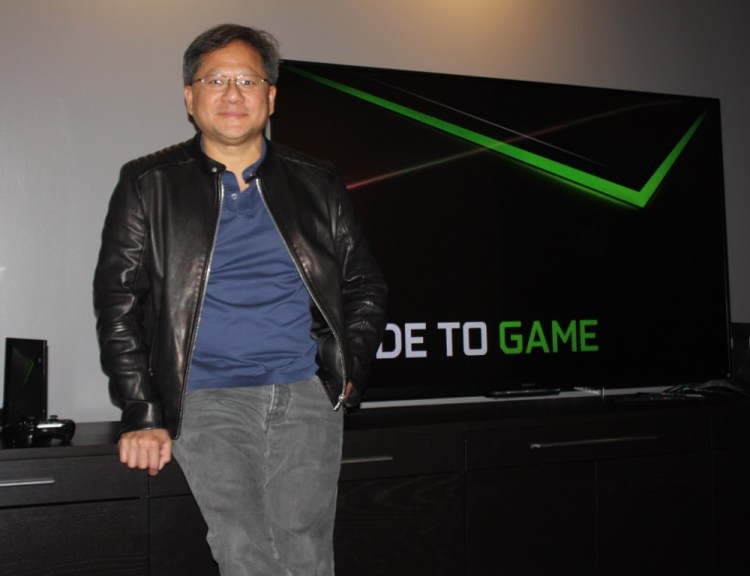Click here for all of GamesBeat’s 2015 Game Developers Conference coverage.
Nvidia‘s new Shield Android TV console, a gaming set-top box with access to Android TV apps, is a bold move to provide the best entertainment experience for gamers and their families.
It raises a lot of questions about specifications, strategy, and other details. Some of those answers aren’t yet available, as Nvidia will launch the set-top box in a couple of months. But we caught up last week with Jen-Hsun Huang, chief executive of Nvidia, in an interview at the company’s headquarters in Santa Clara, Calif. After showing us the Shield set-top box for the first time, Huang answered some questions.
The box is part of a long-term strategy by Nvidia to shift from just supplying graphics chips to providing actual gaming products for enthusiasts. Huang said that the Shield set-top box has been in the works for five years, partly because so many pieces of technology have been built into it. The set-top box will sell for $200 with a basic cloud subscription. It will be available in May.
Here’s our edited transcript of our conversation.
GamesBeat: You can get Steam games playing on the Shield set-top box, if you stream these from your PC. Or you can get them via the Nvidia Grid game-streaming service, right?
Jen-Hsun Huang: This product is self-contained. It doesn’t require you to have a PC.
GamesBeat: Why did Nvidia five years to bring this to market?
Huang: We had to get our Nvidia Grid game-streaming service operating in the cloud.
GamesBeat: But were you waiting for Android TV to arrive too?
Huang: We had to build a graphics processing unit, the Tegra X1, that was really energy-efficient so that we could stream games cost effectively from the cloud. We had to build a virtualization stack for the cloud gaming. We had to build Tegra X1 so it could play high-end games. We had to get the right operating system. This was about as fast as we could get an open TV operating system to market. All of the devices like Shield Portable, Shield Controller, and Shield Tablet had to be built.
GamesBeat: Some of these things you developed over the five years were launched.
Huang: We tried to take whatever products we developed to market as soon as we could, just to test it. We got some expertise and feedback. But the vision for this product took five years.
GamesBeat: How do you feel about calling it a game console? It’s a nomenclature question. Is it a set-top box or a console?
Huang: We think this is more a set-top box. This is really our first living room entertainment device. Our feeling is gaming has gone mainstream. You don’t buy a dedicated device to enjoy games. Just like you don’t buy a dedicated device to enjoy music these days. You don’t buy a dedicated device to watch movies. The time has come for the mobile cloud to do the same thing for gaming as it has for music and videos. All this technology was created to make that possible.
We don’t see it as a replacement for the PlayStation 4. We hope this will expand the reach of gaming. It’s for all the people who think that downloading games or disk games are too much work. This is just click and play instantly.
GamesBeat: One distinction with the game console is that you want to commission and keep exclusive your own games. Sony has The Order: 1886 as an exclusive on the PlayStation 4 now.
Huang: That’s fine. For the people who care about that stuff, they ought to keep playing the PS4 and the Xbox One. I have a PlayStation 4 and I am delighted by it. This is about gaming for everybody else. A few billion people don’t play games. They should have the benefit of this. People want to play a quality game. They just don’t want to spend 12 hours downloading it or going to Best Buy. They want to click and go. We will do for gaming what Netflix has done for movies.
GamesBeat: The set-top box market has a lot of noise in it. Razer’s Forge TV box is coming. Amazon has a box. How do you distinguish it from the other smart TVs and set-top boxes?
Huang: Exactly. This whole category of smart TV and smart TV boxes is popular. But you want to take all of those random boxes and combine it into one. This time has finally come. There are TV streamers, video streamers. We are building a device that is about doing those things and being able to enjoy games as well.
GamesBeat: Tegra X1 also distinguishes it.
Huang: The X1 distinguishes it from other Android boxes. You can pause a game and take it with you.
GamesBeat: If virtual reality comes along and is popular as well, would that become part of this system?
Huang: This Shield is what it is now. I think VR is going to be initially an enthusiast device. This Shield set-top is a living room device. We designed it to take gaming to a mainstream market. In niche markets, people spend a lot of money and tinker with their gadgets.
GamesBeat: Netflix has the nice flexibility of having Dean’s movies and my wife’s with account management. Will you do that?
Huang: We will do that over time. We can do it because it is based in the cloud.
VentureBeat's mission is to be a digital town square for technical decision-makers to gain knowledge about transformative enterprise technology and transact. Learn More




